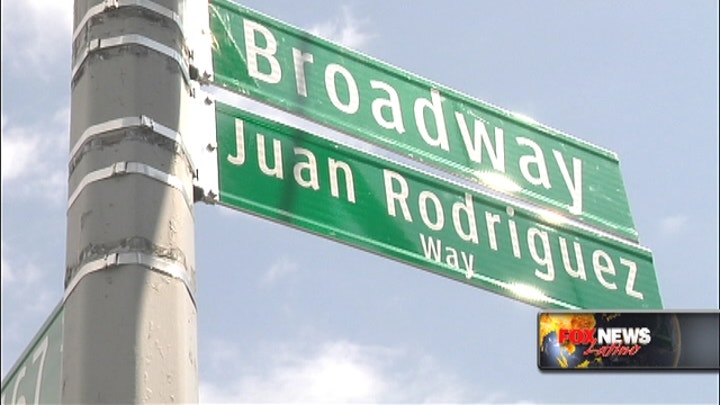
Armando Batista, 34, at the ceremony for Broadway's co-naming of Juan Rodriguez Way on Wednesday, May 16. Batista co-wrote and plays Juan Rodriguez in a play, "I am New York. I am Juan Rodriguez." (Bryan Llenas)
Armando Batista had never heard of Juan Rodriguez. In fact, few Americans likely know that Rodriguez lived 400 years ago as the first immigrant ever to settle in a place known today as New York City.
Nonetheless, Batista, 34, was one among many Dominican Americans in the Big Apple who came out to celebrate the renaming of three miles of Broadway in Upper Manhattan on Wednesday in honor of this man who, until now, was relegated to obscurity.
From159th street in Washington Heights to 218th street in Inwood, New York City's famous Broadway was officially named Juan Rodriguez Way in honor of a free black man from Santo Domingo from the former island of Hispaniola, now the Dominican Republic, who became the first non-native immigrant to ever settle in present day Manhattan in 1613.
Officials unveiled Juan Rodriguez Way sign in a ceremony broadcast live in Spanish in the Dominican Republic as spectators waived Dominican flags and cheered to the sounds of merengue, the island's signature pulsating music.
The significance of the new historical find -- Rodriguez was not only NewYork City's first immigrant, but also its first black dweller, first Latino and first merchant -- has brought a new sense of pride to the city's large Dominican immigrant community, which began flocking to New York City en masse in the 1960s.
Historians believe Rodriguez traveled with Dutch traders, lead by sea captain Thijs Mossel, to the Hudson Bay area where they set up a trading post to barter with Native Americans. When Dutch delegation was set to return home in 1614, Rodriguez convinced Mossel to stay in New York City to maintain the trading post twelve years before the Dutch established New Amsterdam.
There is no evidence that Rodriguez ever left the island and it is believed he eventually married an Indian woman and is thought to have been quite the linguist.
"You’re telling me a Dominican came to New York, before it was even called New York, and stayed here – decided to stay," a shocked Batista, a Washington Heights resident and actor, exclaimed when he first heard of Juan Rodriguez. "That’s crazy. I’ve never heard of this, when I was going to school, in history books."
Batista, whose parents still live in the apartment he grew up in on 187th and St. Nicholas, was so moved by Rodriguez's story that he is playing him in the lead role in a play he co-wrote entitled, "I am New York. I am Juan Rodriguez."
Talk about a role model, said Batista.
"He’s a hero. We need heroes," he said, referring to many hard-working Dominicans in the city living in rather humble conditions.
He hopes youngsters will now proudly refer to this stretch of Broadway "JR way."
"People need to be saying 'I’m going to 187 and JR Way.' It needs to be like that so they will not forget."
Adan Vasquez, 43, teaches music in a high school in Washington Heights, where the student population is about 90 percent children of Dominican immigrants. He brought a delegation to the Juan Rodriguez ceremony -- so they could witness history being made for themselves.
"Juan Rodriguez was a mulatto like me, from the Island of Hispanola," said Vasquez, who immigrated from the Dominican Republic in 1991.
Vasquez said he has witnessed first-hand the struggles immigrant families as they adjust to life in New York City. Juan Rodriguez Way gives immigrants a sense of belonging particularly at a time when anti-immigrant sentiment make some of his students feel unwelcome.
"I believe we all belong, but this is just to show these people historically, that we were here first. We were here before the Irish, we were here before the Italians," Vasquez said.
A former social studies teacher for 13 years, New York City Council Member Ydanis Rodriguez spearheaded legislation that paved the way for the street renaming after Rodriguez.
But success only came with the weight of two years worth of research into Dutch, American and Dominican records conducted by the Dominican Studies Institute of the City College of New York.
"It's the sort of rewriting of the chapter in history that somehow has been overlooked, and has been forgotten," said Ramona Hernandez, director of the institute. "But it’s there. It’s there now. And that’s what counts."
As new waves of immigrants continue to come into New York City, and as gentrification brought on in part by rising rent costs, Louis Then, 50, said the renamed stretch of Broadway will leave a lasting legacy.
"We are leaving our footprints," he said.
For Fedeas Berroja, walking up Juan Rodriguez Way aided by a cane, Wednesday marked a culmination of her own journey, which began when she arrived to New York City some 43 years ago.
"I am a very proud Dominican," said Berroja, flashing a big smile.
Follow us on twitter.com/foxnewslatino
Like us at facebook.com/foxnewslatino

